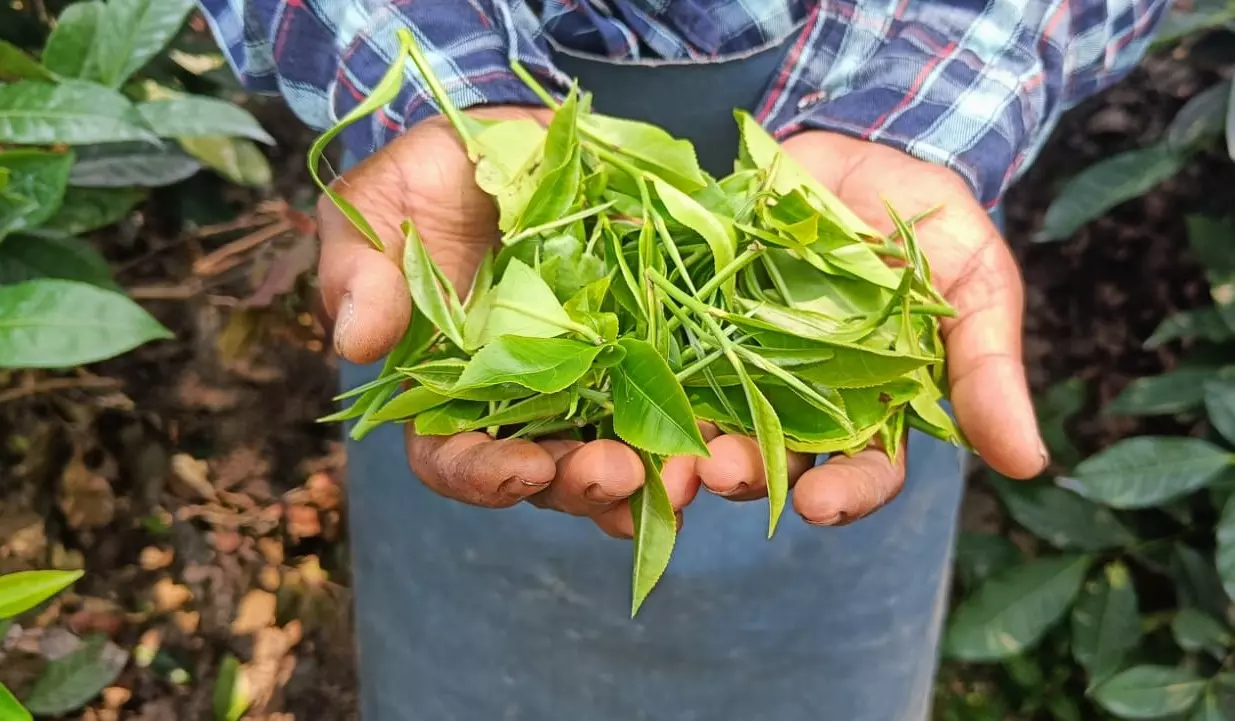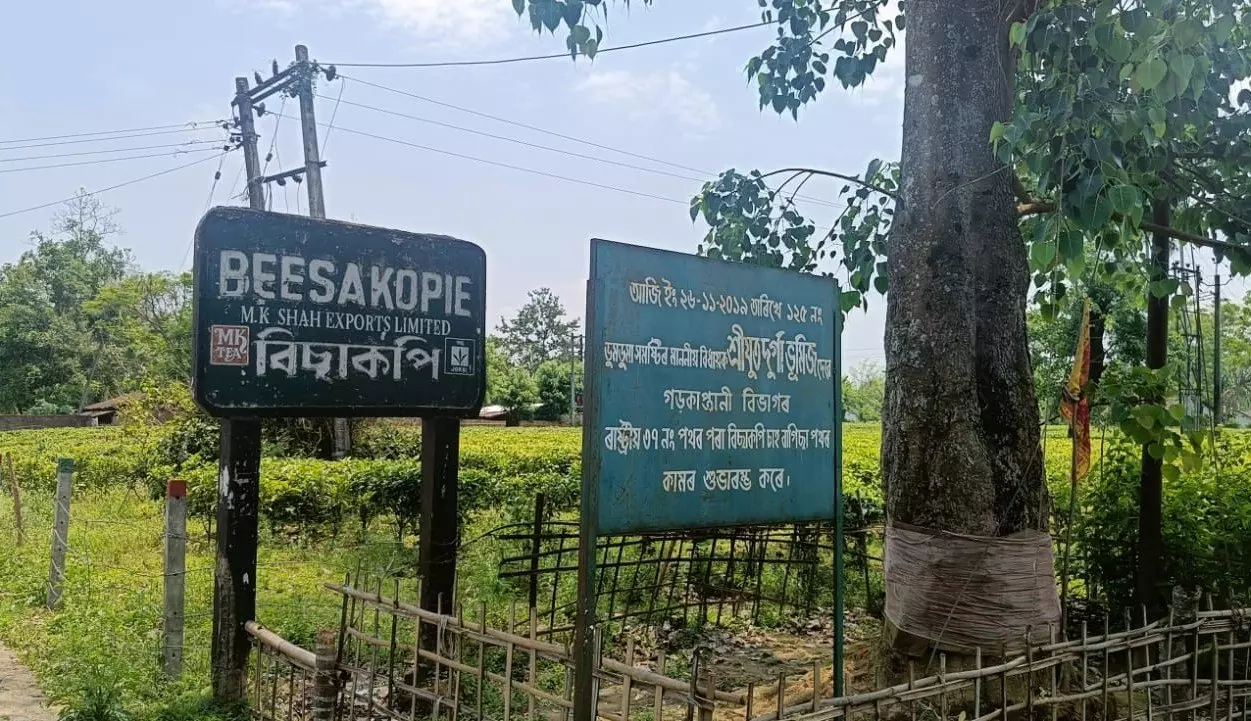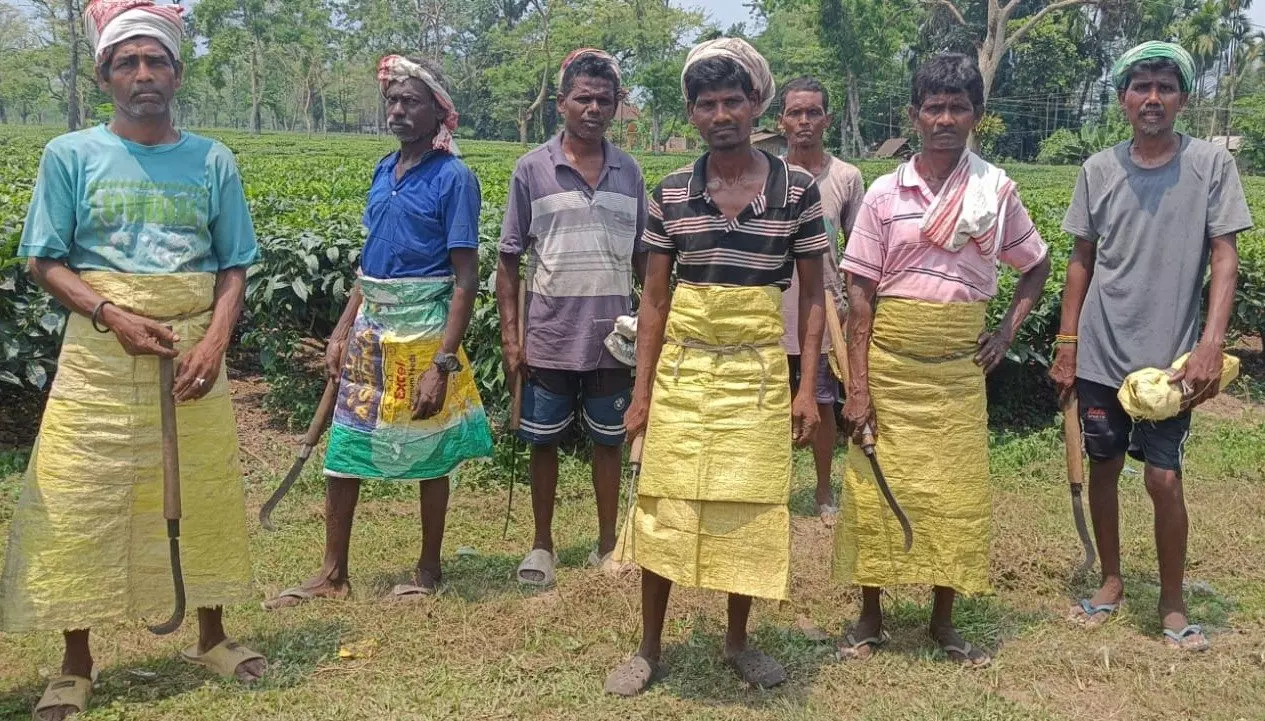
- Home
- India
- World
- Premium
- THE FEDERAL SPECIAL
- Analysis
- States
- Perspective
- Videos
- Sports
- Education
- Entertainment
- Elections
- Features
- Health
- Business
- Series
- In memoriam: Sheikh Mujibur Rahman
- Bishnoi's Men
- NEET TANGLE
- Economy Series
- Earth Day
- Kashmir’s Frozen Turbulence
- India@75
- The legend of Ramjanmabhoomi
- Liberalisation@30
- How to tame a dragon
- Celebrating biodiversity
- Farm Matters
- 50 days of solitude
- Bringing Migrants Home
- Budget 2020
- Jharkhand Votes
- The Federal Investigates
- The Federal Impact
- Vanishing Sand
- Gandhi @ 150
- Andhra Today
- Field report
- Operation Gulmarg
- Pandemic @1 Mn in India
- The Federal Year-End
- The Zero Year
- Science
- Brand studio
- Newsletter
- Elections 2024
- Events
How ‘unfair pricing’ of leaves is brewing a storm in Assam’s small tea gardens
Once the pride of Phillobari and the backbone of Assam’s famous tea industry, small growers face unfair prices and decline in production, leaving many questioning whether the state’s iconic brew has a future

Kalpa Sonowal, 36, from Assam’s Tinsukia district, has been tending his small tea garden since he was 16, while still a school student. Nearly three decades ago, Sonowal’s father decided to cultivate tea on a 10-bigha (around 6.7-hectare) plot of land in Phillobari, their ancestral village. In Phillobari, almost every household owns a small tea garden. Most villagers have converted...
Kalpa Sonowal, 36, from Assam’s Tinsukia district, has been tending his small tea garden since he was 16, while still a school student. Nearly three decades ago, Sonowal’s father decided to cultivate tea on a 10-bigha (around 6.7-hectare) plot of land in Phillobari, their ancestral village.
In Phillobari, almost every household owns a small tea garden. Most villagers have converted their bari (the traditional kitchen garden) in their backyards into tea gardens. Others grow tea in the fallow lands at their disposal. The elders in Phillobari recall that in the late 1970s, their village saw a ‘mini revolution’ when every family decided to concentrate on growing tea, instead of other crops and vegetables.
The ‘mini revolution’ of Phillobari was seen across Assam almost five decades ago when marginal farmers with small land holdings started cultivating tea, a terrain hitherto dominated by rich tea estates with hundreds of hectares of land.
Assam is globally recognised for its tea. The Northeastern state produces nearly 700 million kilograms of tea annually, accounting for around half of India’s overall tea production. Of this, around 48 per cent is cultivated by more than 1,22,000 small tea growers in the state who cultivate tea on approximately 1,14,000 hectares of land.
There was a time when people across Assam and neighbouring Arunachal Pradesh visited Phillobari to enjoy quietude amidst the jaw-dropping beauty of its lush green tea gardens — the pride of every household.

A woman labourer in Assam's Lakhimpur district holds green leaves in her hand. Photo Maitreyee Boruah
Sonowal, standing in the middle of his tea garden, says the revolution is almost over. “Our gardens have become a burden. Growing tea has become a loss-making enterprise for the farmers. Several villagers have stopped growing tea. Now they grow vegetables or do odd jobs like daily wage earners.”
Phillobari’s plight is not just limited to its villagers. Small tea growers across Assam are facing one of their worst crises in decades as the price of green leaves has plummeted to as low as Rs 11 a kilogram this year. According to the Tea Board India, a small tea grower farms the crop on up to 10 hectares (around 40 bighas) of land. However, currently, most growers own less than 0.8 hectares (3.9 bighas) of land.
Also read: Eviction drives in Assam’s Golaghat leave migrant Muslim families pushed to a corner
A bigha of land produces 1,800-3,000 kilograms of green leaves annually. If we get Rs 11 a kilogram from the buyers (the factories), after paying the labour charge and maintenance charge (including the cost of pesticides), a farmer is left with Rs 2 a kilogram. Thus, on a bigha of land, a farmer earns around Rs 6,000 a year (if it produces 3,000 kilograms). As I grow tea in 10-bigha land, my earnings this year would be around Rs 60,000,” Sonowal explains with numbers.
“Moreover, the plucking season has also been reduced due to climate change (mostly the late arrival of rainfall). Earlier, plucking of leaves started from late February and continued till the early weeks of November. Now, it starts from June to November. Thus, production has also decreased. There is almost no profit in growing tea, which is pretty labour-intensive,” he adds.

Beesakopie Tea Estate in Tinsukia district is one of Assam’s biggest tea plantations. Photo: Maitreyee Boruah
Sonowal completed his bachelor’s degree in commerce while working in his father’s tea garden after college hours. Instead of looking for a job after college, he became a full-fledged farmer, as his father was growing old and tired and was struggling to look after the garden. “I thought I had to keep my father’s dream alive. He started the garden with great love for tea (the quintessential Assamese sah, which everyone loves to drink at least twice a day). He toiled hard to grow the bushes from scratch,” Sonowal recalls.
Now, he is in a dilemma whether to keep tending his garden or abandon it like many in Phillobari. Sonowal has been involved in poultry farming for the last few years to keep his household afloat. “I can’t rely only on my tea garden to manage my household expenses. I have to look after my parents, wife and child. Poultry farming gives me a steady income. Otherwise, we would have been in a soup,” he says. The 36-year-old adds that not all tea growers are lucky, as they don’t have the knowledge or skill to diversify. “Some tea growers toil from morning to night. They themselves pluck leaves as they can’t afford to hire labourers. They are becoming poorer day by day.”
Also read: How Assam’s visually impaired keep learning to read and write against all odds
Around 50 kilometres from Phillobari is Joriguri village in Dibrugarh district (known as the tea capital of India, with more than 140 big tea plantations). Tea gardens surround Joriguri. Robin Gogoi, 47, has been a small tea grower for almost 25 years in Joriguri. He is distraught because of his mounting debt.“I am in debt and unable to maintain the garden well. I am struggling to pay the daily wage of labourers. I am worried my financial woes will sabotage my children’s education. Both my daughters are in college,” Gogoi says. He took loans from his acquaintances and did not want to reveal the exact amount. “I hardly earn Rs 6,000 a month. My wife is a home-based handloom weaver. She earns a few thousand rupees a month. With this kind of earning, my family is struggling, and paying back my debt has become a herculean task,” he adds.

A group of small tea growers and labourers in Assam’s Lakhimpur district. Photo: Maitreyee Boruah
But Gogoi has no plans to stop growing tea leaves. “Do I have any option? I can’t just do something else at this age. I want the government to intervene and help small farmers to resolve our financial crisis,” he says.
The 200-year-old tea industry is synonymous with Assam. Along with gaining global fame for its high-quality tea, Assam earns huge revenue from the green leaves. India earned Rs 6.386 crore by exporting tea in 2022-23, and Assam contributed to a sizable chunk of it.
However, the small tea growers, the backbone of the biggest revenue-generating industry of the Northeastern state, are experiencing their worst time. The situation is so dire that several senior members of the All Assam Small Tea Growers’ Association (AASTGA), the umbrella body representing the small farmers, fear that Assam will stop producing tea in a decade.
Rajen Bora, president of the AASTGA, reiterates that factories buy tea leaves from small tea growers at a pittance. “Till July, a bought leaf tea factory (it purchases tea leaves from small tea growers for processing into finished tea products) was paying Rs 18 for one kilogram of green tea leaves. The price has crashed to Rs 11 currently. Moreover, the price of tea leaves varies from place to place. The fluctuating and arbitrary prices are causing havoc to small farmers,” adds Bora.
Bora, a small tea farmer since 1991, explains that in the early 1990s, a kilogram of tea leaves fetched farmers Rs 6, and the wage of a tea garden labourer was Rs 12 a day. “Now, the daily wage is Rs 250 for a labourer. But we are selling tea leaves at Rs 18 per kilogram (or as low as Rs 11 a kilogram). Earlier, we were getting half the daily wage of a labourer for every kilogram of tea leaves sold. Keeping that logic, we should get Rs 125 per kilogram of our produce from the factory owners.” Bora cultivates tea in 7.9-bigha (or 2-hectare) land in Assam’s Jorhat. He usually employs six to eight workers to pluck leaves.
The tea garden labourers, mostly Adivasis, have been demanding a rise in their salary to Rs 350 a day. The low wages of the labourers are one of the main causes of large-scale poverty in tea gardens. “Do you think Rs 250 (sometimes even as little as Rs 150) for eight-10 hours of labour is enough to run a household? That is why Adivasi people, mostly tea garden labourers, residing in and around the plantations have been fighting poverty for so long,” says Milika Topno, a lawyer, whose parents are both tea garden labourers in Assam’s Lakhimpur district.
Apart from unfair pricing, tea growers are worried about a decline in tea production (a 12 per cent decline till June 2025 compared to 2024), the various impacts of climate change, and blending (where cheap tea from foreign countries like Kenya, Sri Lanka and Nepal is mixed with Assam tea for profit), to name a few.
Achyut Baruah, a small tea grower and member of the AASTGA from Golaghat district, stresses that the issue needs to be addressed by the government. “Tea Board India and price monitoring committees under district commissioners should ensure fair prices. They need to hold discussions with growers. The growers have been demanding a fixed minimum support price for tea leaves. The influx of low-quality, cheap tea imports from other countries is hurting the domestic market,” Baruah adds.

Women and children of families of small tea farmers in Assam’s Dibrugarh district. Photo: Maitreyee Boruah
Arunita Phukan Yadav, executive director of Tea Board India, tells The Federal that the board is not directly involved in determining the price of green leaves. “We monitor the quality of tea leaves. The prices should be based on the quality of tea leaves.”
In his late 60s, Purananda Brahma, a former tea farmer from Assam’s Chirang district, recalls that from the late 1970s till the early 2000s, small tea growers were provided financial incentives by the government to cultivate tea in small patches of land. “Last, I remember the government provided financial assistance of around Rs 75,000-Rs 80,000 to people to grow tea. That was stopped almost 25 years ago as thousands took up growing tea wherever they found land,” says Brahma.
Also read: How Makhana cultivation in Bihar leaves farmers struggling for survival
He adds that this has also led to a compromise on the quality of leaves. “The factories took advantage of it and started paying whatever they wanted. The farmers can’t protest because each area has one to five factories, and these factories have a monopoly. Moreover, it is the big plantations that control how tea is produced, processed and marketed.”
Assam has around 800 big tea estates. Members of the AASTGA allege that the cess (tax) introduced by the Assam government under the Cess Utilisation (Amendment) Policy, 2015, which charges 25 paisa for every kilogram of green leaves sold by small farmers to factories, is doing no good. “The government introduced the tax with the promise that the amount would be given back to the marginal farmers for the upkeep of their gardens. The amount, which is in crores, is lying in the government treasury. It is high time the government releases the funds to help farmers,” says AASTGA president Bora.
In March, the AASTGA, along with other organisations like the Indian Tea Association, submitted a “Status Paper on the Small Tea Sector of Assam” to the Assam government. The document highlights limited bargaining power, lack of access to financial support, limited access to training and technology and price distortion as key issues plaguing farmers with small landholdings.
“These issues can be resolved by ensuring fair and remunerative prices for small tea farmers. The government needs to extend the benefits of schemes that apply to agricultural farmers to small growers. The influx of green leaves from other places has to stop,” says farmer Gogoi from Dibrugarh’s Joriguri village. “Otherwise, farmers like me see no hope and future for our children,” he adds.
